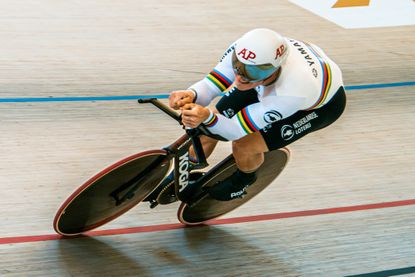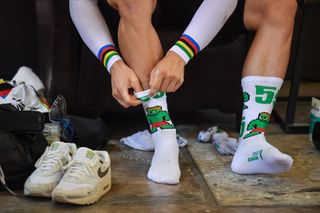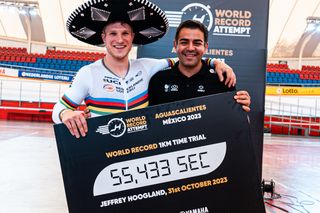'I will hopefully not be forgotten': How Jeffrey Hoogland broke track sprinting's oldest record
Last October, Jeffrey Hoogland roared to a new kilometre time trial world record. Tom Davidson spoke to the Dutchman and his team to find out what it took


Today, 31 October, marks one year since Jeffrey Hoogland broke the kilometre time trial world record in Aguascalientes, Mexico. The following feature was published in Cycling Weekly magazine in November 2023. Subscribe now and never miss an issue.
It might come as a surprise, but Jeffrey Hoogland needed to be persuaded to have a punt at the kilometre time trial world record. “He took a lot more convincing than I thought,” his coach, Mehdi Kordi, tells Cycling Weekly. “I said, ‘Do you fancy a trip to Mexico where it can be all about you, and the upshot is that you become the world record holder?
“He was like, ‘I’m not sure. I want to be world champion first.’ And that kind of threw me. I was like, ‘I’m pretty certain you’re going to be world champion on your worst day.’”
Hoogland’s form in the event had, after all, been unrivalled in recent years. He had held the rainbow bands since 2021, and this February became the first person to go under 58 seconds at sea level. Kordi knew the record was within grasp. Hoogland was doubtful.
“The irony of it all, was that plans were already in place,” the coach reveals. “The ball had got rolling in April, without him really knowing too much.”
Six months later, in the Mexican city of Aguascalientes, Hoogland flipped the longest-standing record in track cycling on its head. It took him 55.433 seconds to snatch the bragging rights from Frenchman François Pervis, shaving 0.87 seconds off a benchmark that lasted for almost a decade.
“Every time I think about it I get this amazing feeling,” Hoogland says, speaking to Cycling Weekly from a beach resort on the Caribbean Sea. “I didn’t just want to set a new world record, I wanted to set it so it’s pretty hard to ever beat again.”
Get The Leadout Newsletter
The latest race content, interviews, features, reviews and expert buying guides, direct to your inbox!

The velodrome in Aguascalientes is a popular destination for world record attempts. Sitting at 1,887m, the altitude’s low air density reduces aerodynamic drag, something that Italian Vittoria Bussi knows well, having set her hour record there.
Hoogland’s team came across a road block in planning. They had originally hoped to run the sprinter’s kilo effort as a race, with a rider on the opposite side of the track offering a drag advantage, as Pervis had had ten years prior. This, it turned out, would not be possible. Due to governance infringements, the UCI has suspended the Mexican Federation, meaning Hoogland would have to stage an official world record event, and ride the track alone.
Kordi, however, had a trick up his sleeve. To generate airflow, he planned to send a motorcyclist onto the boards in the minutes before the effort. “He was whizzing around at 70km/h, and as soon as we gave the signal, he was off in five seconds,” the former British Cycling sprint coach says. “I think it had an effect. When we were standing on the track, we felt it.”
They practiced the motorbike’s track exit in the days before the effort. One thing they could not prepare for, though, was the sudden drop in atmospheric conditions. “[Hoogland] did the effort on the worst day he could have done it on,” says Kordi. The velodrome in Aguascalientes relies on warm air pumped in from outside to heat up, the coach explains. “On the days leading up to it, it was great, it was really sunny. We were getting up to like 30, 32 degrees. But on the day, it was like 23.8 or something.”
Since arriving in Mexico, Hoogland did very little training on the track. Fortunately, he already knew the boards. “I was there 10 years ago and I expected it to maybe have gotten worse over time, but it was exactly how I remembered it,” Hoogland says. “The corners are pretty harsh, they turn rapidly and you get smashed in pretty hard.”
The sprinter opted for a 70-tooth chainring, the largest he has ever used. Although he did not use a power meter crank – “unfortunately he breaks those,” says Kordi – he is thought to have reached almost 3,000 watts in his opening lap, his peak torque coming in the standing start.

By the time he was up to speed, Hoogland was flying. He wore a special skinsuit, developed by clothing brand AGU. It had been tested in a wind tunnel using a mannequin of Wout van Aert, the most comparable one to Hoogland that they had lying around. The suit contained fabrics used in speed skating, so when the sprinter neared 80km/h on his second lap, the aerodynamic drag was less.
The third and fourth laps, Hoogland explains, were a matter of just hanging on. “My lines were pretty good, even with the harsh corners, it was really fluid,” he says. “The biggest mistake was the last turn when I went into the red, but at that point I couldn’t focus or see anymore. My head went down, my neck was tired.”
Afterwards, Hoogland twisted his face in pain as he lay beside the track. The live feed, broadcast to 150,000 people at its peak, showed him gasping into a humidifier face mask, wearing the grimace of a man immobilised by the lactic acid in his legs. “I got really dizzy, a little bit nauseous,” he says. “But I think that was all normal, considering the circumstances at high altitude. It was really extreme. Everything was more intense than ever before.”
It would end up taking Hoogland more than half an hour to compose himself after his effort. He then changed his socks, pulling on a pair with the number 55 - his new time benchmark - and cartoon images of the Hulk, the comic book character who lends the sprinter his nickname.

Hoogland's world record in numbers

Time: 55.433 seconds
Lap times (seconds):
1 (standing start) - 17.5
2 - 12.0
3 - 12.4
4 - 13.3
Average speed: 64.943km/h
Top speed: 79km/h
Max power (estimated): 3,000w
Hoogland's double leg press PB: 760kg (equivalent to a 1990s Mini Cooper)
Originally, the cost of the project was estimated to be in the region of €65,000 (£56,500), with funding coming from various sponsors, such as Nederlandse Loterij, financial consultant AP Support and Japanese giant Yamaha, but it ended up costing “significantly more”, Kordi hints.
For Hoogland, the value was more personal. As he enters his third decade, the Dutchman is beginning to think more and more about his legacy in the sport. “I’m a bit of an older athlete at the moment and I don’t know how long my career will go on,” the 30-year-old says frankly. “I think as soon as you get older, your legacy starts to become more important. I’ve achieved great stuff, actually everything I’ve wanted in my life already with track cycling.”
Today, Hoogland holds three out of the four men’s sprint world records: the kilometre time trial, the team sprint (set at the 2020 World Championships) and the flying 500m, which he achieved in the middle two laps of his kilo.
The day after his successful attempt, Hoogland returned to the track to try to complete the set with the flying 200m. “I was actually surprised by how close I came,” he says. The sprinter landed three hundredths of a second short of the 9.1 second record, and after another, slower attempt, called it a day. “No hard feelings,” he says, looking back. Later that afternoon, he went back to his hotel, where he shared “some beers” and “some laughs” with his team.
“Maybe I’ll go for the 200m next time, or another time,” Hoogland says. “Everything I add now is even better and more fun. I love that people will remember me as one of the greatest in track cycling and I worked really hard for that. I will hopefully not be forgotten in track cycling. That is really important to me.”

Kilo-killing kit

When it comes to designing a kilo-record-setting bike, “stiffness is more or less the main goal,” says Tim de Boer, the head mechanic of the Dutch track team. “Especially with a rider like Jeffrey, we mainly look for stiffness and aerodynamics. Weight is a little bit less important.”
Hoogland’s Koga track bike weighed 7.7kg and, according to De Boer, is worth around €21,000 in its constituent parts.
The sprinter used a 70-tooth carbon Digirit chainring - the biggest he has ever ridden - with a 15-tooth rear cog. “I think the kilo is maybe the hardest event regarding gearing, because everything is in it,” the mechanic says. “You have a standing start, a really high top speed, and you will also slow down at the end. We felt that the gear was pretty perfect.”
For better handling, Hoogland chose to mismatch his wheels, running a Mavic Comete front disc and a rear Campagnolo Ghibli disc. His Dugast tubular tyres - 20mm in width at the front, 23mm at the rear - were pumped to 200psi. “Most teams do it like that,” De Boer says, explaining that higher pressures offer less rolling resistance and greater control in the corners.
Although Hoogland’s Speedbar TT extensions were brand new, his PRO Missile base bar was over a decade old, the team opting for a familiar, reliable model for fear that he might snap a different one. The pedal straps, De Boer explains, were developed specially to withstand Hoogland’s power.

Thank you for reading 20 articles this month* Join now for unlimited access
Enjoy your first month for just £1 / $1 / €1
*Read 5 free articles per month without a subscription

Join now for unlimited access
Try first month for just £1 / $1 / €1

Tom joined Cycling Weekly as a news and features writer in the summer of 2022, having previously contributed as a freelancer. He is fluent in French and Spanish, and holds a master's degree in International Journalism, which he passed with distinction. Since 2020, he has been the host of The TT Podcast, offering race analysis and rider interviews.
An enthusiastic cyclist himself, Tom likes it most when the road goes uphill, and actively seeks out double-figure gradients on his rides. His best result is 28th in a hill-climb competition, albeit out of 40 entrants.
-
 VanMoof e-bikes back on sale in UK with promise of 'more reliable' models
VanMoof e-bikes back on sale in UK with promise of 'more reliable' modelsThe Dutch brand went bust last summer, but is now back with improved S5 and A5 and a new repair system
By Adam Becket Published
-
 Amateur cyclist breaks Strava KOMs on Mortirolo and Stelvio, makes plea for pro contract
Amateur cyclist breaks Strava KOMs on Mortirolo and Stelvio, makes plea for pro contract'Let's hope some kind of opportunity comes from this,' said Canadian Jack Burke, after taking the Mortirolo crown
By Tom Davidson Published
-
 Six-day events no longer have to last six days, UCI rules
Six-day events no longer have to last six days, UCI rulesRegulation update gives track racing organisers more freedom over duration
By Tom Davidson Published
-
 90-year-old cyclist sets sights on four world records
90-year-old cyclist sets sights on four world recordsThree-time Masters world champion Walter Fowler is far from ready to slow down yet
By Tom Davidson Published
-
 London 3 Day live stream: Watch Sunday's action on Cycling Weekly's YouTube channel
London 3 Day live stream: Watch Sunday's action on Cycling Weekly's YouTube channelWatch live as track cycling stars go head-to-head at the Lee Valley Velodrome
By Tom Davidson Published
-
 London 3 Day live stream: Watch Saturday's action on Cycling Weekly's YouTube channel
London 3 Day live stream: Watch Saturday's action on Cycling Weekly's YouTube channelWatch live as track cycling stars go head-to-head at the Lee Valley Velodrome
By Tom Davidson Published
-
 London 3 Day live stream: Watch Friday's action on Cycling Weekly's YouTube channel
London 3 Day live stream: Watch Friday's action on Cycling Weekly's YouTube channelWatch live as track cycling stars go head-to-head at the Lee Valley Velodrome
By Tom Davidson Published
-
 'I was in hospital six weeks ago': 80-year-old Brit wins three world titles
'I was in hospital six weeks ago': 80-year-old Brit wins three world titlesFormer Olympian track cyclist Geoff Cooke trains up to 300 miles a week
By Tom Davidson Published
-
 Britain's lost track sprinter returns as Olympic medallist Matthew Richardson switches nationality
Britain's lost track sprinter returns as Olympic medallist Matthew Richardson switches nationality'This decision is about following my passion and pushing myself to new heights,' says 25-year-old, who until now has represented Australia
By Tom Davidson Published
-
 'I slept in a horse barn' - Meet the track cyclist who funded his own way to the Paris Olympics
'I slept in a horse barn' - Meet the track cyclist who funded his own way to the Paris OlympicsSouth African Jean Spies is a two-time Olympian, thanks to his determination and the generosity of others
By Tom Davidson Published